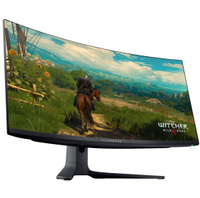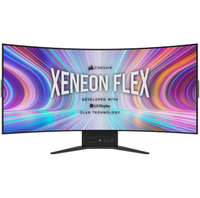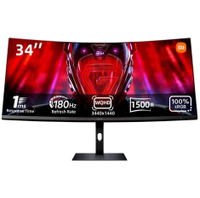Best curved monitors for gaming in 2024: These are the bendy displays I'd immerse myself in
Immerse yourself to the max with these vision-enclosing panels.

The best curved gaming monitors are best suited to immersive gaming experiences. The wider the screen, and the curvier the panel, the more of your vision is engrossed in your game.
The best curved gaming monitor right now is the Alienware 32 AW3225QF, which offers seriously fantastic high-end visuals thanks to its Samsung 3rd Gen QD-OLED panel. It packs in tons of pixels into 32 inches of screen space, and of course maintains the snappiness and vibrancy of the best OLED gaming monitors on the market today.
You don't need to spend thousands on a decent curved monitor either. If you're looking to spend less cash, you might consider the Pixio PXC277 Advanced, which is our pick for the best budget curved monitor right now. It's not got the deepest curve, but you wouldn't want that with a 16:9 27-inch panel. Its 165 Hz refresh rate and 1 ms rated response times are very respectable for gaming today, and it's great that there's now a monitor like this going for such a reasonable price.

Dave's been testing PC hardware for the best part of 20 years and has seen every kind of screen imaginable. As such he knows what makes differentiates good curves from bad curves, as well as what makes for a great gaming monitor in general. Whether we're talking LCD, OLED, mini-LED, or plain ol' CRT, he's had his eyes on them all and has personally checked out all of theaw best curved gaming monitors.
The Quick List
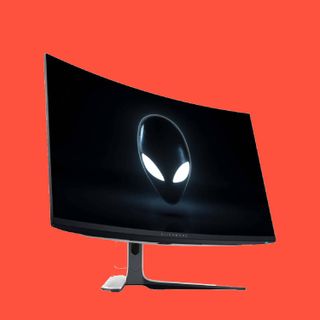
The best overall
This 32-inch Alienware OLED display packs some seriously high-end specs and impressive pixel density. It's a 16:9 stunner, but if you're looking for ultrawides, we've got them here too.

The best budget curved
The PXC277 is far from a bargain basement item. At this price point, we were willing to make a few excuses, but that's not actually necessary here. This monitor delivers: The Pixio PXC277 Advanced does almost everything pretty darned well without breaking the bank.

The best ultrawide curved
This monster essentially sticks two stunning 4K monitors side-by-side. It does cost a pile of money, but this is still the most spectacular gaming experience currently available.
⬇️ Load more of the best curved gaming monitors

The best budget ultrawide curved
This monitor packs some great contrast thanks to its VA panel, with tons of backlight punch (provided you run the screen in HDR mode), decent pixel response times, and a respectable refresh rate.
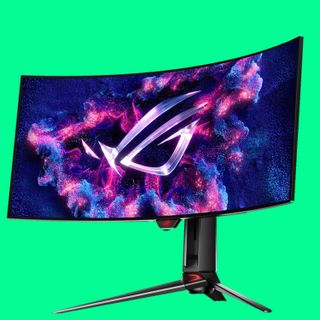
The best ultrawide OLED curved
With this Asus display's superb image quality, excellent text handling, and a super-fast 240 Hz refresh rate, there's very little not to like about this stunning OLED display. Oh, apart from its price, but did you expect any less of an ultrawide OLED?
Recent updates
Updated September 10, 2024 to update our picks for the best curved gaming monitors, ensuring they're the best options currently on the market, and changing the guide to our new format.
The best overall curved gaming monitor





Specifications
Reasons to buy
Reasons to avoid
✅ You want 4K crispness and OLED lighting: Perfect per-pixel lighting, snappy OLED speed, plus 4K pixel density is an incredible combo.
❌ You want a simple life: What with all the HDR settings and the OLED panel management, life isn't simple in 4K OLED land.
The Alienware 32 AW3225QF is the best curved gaming monitor because, simply put, it ticks all the high-end display boxes. You're not getting any somewhat more niche features such as an ultrawide aspect ratio or ultra-curved panel. No, you're just getting a gorgeous 16:9 display with some stellar specs to boot.
The AW3225QF runs a Samsung 3rd Gen QD-OLED panel which really brings high-end OLED gaming in for a home run. To be specific, the Alienware 32 AW3225QF has somehow crammed a 4K resolution-load of pixels into a 32-inch OLED screen for some seriously stunning pixel density.
This pixel density, apart from aiding wonderful in-game visuals, also helps mitigate text fringing, which is a common complaint about OLED panels. You have to get very close to see any fringing on this thing, and even then it's slight.
You're getting solid specs all around, too. We're talking 0.03 ms response times, 1,000 nits peak HDR and 250 nits full-screen brightness, and 99% DCI-P3 coverage. Oh, and a 240 Hz refresh rate. You can't ask for much more for gaming—you're getting a fast and responsive experience in addition to gloriously vibrant and crisp visuals.
The only downsides to this monitor, apart from its expensive price tag, are the same ones that face almost any OLED. As our Jeremy said in his review, this thing is "an elusive angstrom or three away from perfection", these angstroms borne from the added difficulty required to keep on top of burn-in mitigation settings and measures, plus the fact that "there's not a single optimal setting for HDR".
Still, these are little niggles in the face of an extraordinarily capable monitor that delivers an incredibly fast and vibrant display experience. It would be a fantastic panel whether curvy or not, but throw in its subtle 1700R curvature and you have the best curved gaming monitor on the market. It's well worth a look if you can spare the cash.
Read our full Alienware 32 AW3225QF review.
The best budget curved gaming monitor





Specifications
Reasons to buy
Reasons to avoid
✅ You want a great value curved display: You're getting a spec list here that would have set you back double this price just a few years ago.
❌ You want to use HDR in games: The peak brightness and weak backlighting don't help the HDR experience, so you'll be sticking to SDR at all times.
The Pixio PXC277 Advanced is the best budget curved gaming monitor because it's a solid all-rounder for the price. Nothing unnecessary, just a monitor that nails all the fundamentals at a very reasonable price.
With the PXC277 Advanced, you're getting a 27-inch, 165 Hz monitor with a 1 ms response time. Importantly, at 320 nits, this monitor is brighter than some more expensive VA panels, and of course still delivers on the lovely deep blacks that VA panels are famed for.
Its 1 ms rated response time isn't quite as snappy as this in practice, but if you set overdrive to low you can get a fast experience with little ghosting or overshoot. You're always going to get slightly higher latency with a VA panel, but the PXC277 is far from the worst in this regard.
Put all this together and you have a monitor that will suit most gamers. It's fast and snappy enough for most, and, most importantly, you're getting stellar visuals straight out of the box. While it has a lacklustre HDR experience, the monitor's calibrated well and things look pretty vibrant for such a cheap monitor, with lovely deep blacks and stellar contrast.
The icing on the cake is that this thing doesn't look at all budget on the desk, thanks to its premium-looking bezels and tri-leg metal stand. For the price, you can't really go wrong with this one.
Read our full Pixio PXC277 Advanced review.
The best ultrawide curved gaming monitor



Specifications
Reasons to buy
Reasons to avoid
✅ You want the ultimate gaming experience: This level of pixel density has never been available before on such a large screen and it's incredible to see.
❌ You're expecting OLED-levels of perfection: Samsung has done a great job of improving its VA panels, but it's still no match, in terms of image quality and speed, for a decent OLED monitor.
If you're looking for mega-sized curved ultrawide, this is it. The Samsung Odyssey Neo G9 G95NC is the best ultrawide gaming monitor because Samsung's basically slapped two stunning 4K 32-inchers together and called it a day. And what else could you want, really?
This thing is the least subtle display we've come across, and for that reason we absolutely love it. A bit like a flagship graphics card , you probably already know if you want one of these things. If you want something that's gorgeously overkill and you have the money to spare, nothing we say will change that—ditto if you don't.
The G9 G95NC has a steep 1000R curvature which suits its ridiculous 57-inch wideness, and its 2160 pixels on the vertical axis are outmatched by an outrageous number on the horizontal (7680 of them, if you must know). Combine this with a 240 Hz refresh rate and a plethora of ports and there's nothing to complain about here.
If it's not obvious, the experience you'll get gaming on this thing will involve some serious immersion: screen all around you and some DisplayHDR 1000 for stellar colour reproduction and detailed bright and dark spots.
Just don't go expecting your RTX 4090 to be able to utilise it at anything above 120 Hz at 4K, because it can't thanks to its DisplayPort spec. And it's unlikely a top-end AMD card will be able to pump out the frames for this monitors native res and refresh rate, either, depending on the game of course.
But, with this display, the stunning visual capabilities will be there if you ever need them. So, if you're up for sheer curved ultrawide luxury, you don't need to look much further than the Neo G9 G95NC.
Read our full Samsung Odyssey Neo G9 G95NC review.
The best budget ultrawide curved gaming monitor







Specifications
Reasons to buy
Reasons to avoid
✅ You want ultrawide on a budget: Ultra widescreen gaming is super immersive but can get very expensive to enjoy. That's not the case here.
❌ You want the best out-of-the-box experience: ASRock's monitor needs a fair bit of tweaking and calibration to run and look as good as it can, but that's to be expected at this price point.
The best budget ultrawide gaming monitor is the ASRock Phantom PG34WQ15R2B because its reasonable all-round specs show just how far monitors have come when you can get a very decent ultrawide for an affordable price. This is ASRock's first gaming monitor, too, which is impressive. The company's made an incredibly well-rounded display.
The PG34WQ15R2B has a 34-inch ultrawide VA panel capable of up to 165 Hz at 1440p. This refresh rate and resolution combo is, crucially, a solid mainstream gaming standard today, even for a non-ultrawide. Which makes this monitor even more impressive given it shoves in a bunch of extra pixels on the horizontal axis. It's also rated up to an impressive 550 nits peak brightness and it claims a 1 ms MPRT response time.
So, really, probably the best way to think of this monitor is as an ultrawide version of the Pixio PXC277 Advanced above. You're getting a solid all-round budget screen just like the PXC277 but with some extra horizontal real estate.
Combine this display's unusually high peak brightness with its 3,000:1 contrast and DisplayHDR 400 certification, and you have the makings of a decent HDR experience—nothing akin to true HDR, though, of course. This is exactly the kind of thing we're looking for with a cheaper ultrawide monitor, as it helps with casual gaming immersion.
As with any VA monitor, It's certainly not the best pick for purely competitive gamers, given that this panel tech isn't quite as responsive as IPS tech. But its response times are respectable and, for your average gamer, the PG34WQ15R2B is a cracking deal. It's certainly the best curved ultrawide we've spotted for this kind of price.
Read our full ASRock Phantom PG34WQ15R2B review.
The best ultrawide OLED curved gaming monitor





Specifications
Reasons to buy
Reasons to avoid
✅ You want the best OLED can offer right now: And that's a whole lot. While first-gen panels are great, these more modern units really are top-notch. Add in some very nice curves and you have something truly amazing.
❌ You're not looking to spend a lot: It's dropped in price a fair bit since launch, but you'll still be paying north of $1,000 for this superb display.
The Asus ROG Swift OLED PG34WCDM is the best ultrawide OLED curved gaming monitor thanks to its gorgeous LG OLED panel. The pick for this spot on our list is hotly contested, but the PG34WCDM deserves the win, here.
Its 3,440 x 1,440 resolution, 240 Hz refresh rate, and 99% DCI-P3 color coverage wouldn't be setting any new records for VA or IPS panels, but for an OLED panel these specs are very impressive. But it's how this thing's display looks in person that really makes it stand out.
We used the word "zing" in our review for this monitor, and that sums it up nicely. It handles HDR adeptly and has all the OLED loveliness you could hope for—super vibrant colors, perfectly deep blacks, and stunning general picture quality. Put simply, it's a jaw-droppingly good-looking display, and it's plenty fast at 240 Hz, too.
This monitor also works hard to keep the common complaints about OLEDs, such as text fringing, to a minimum. Its Clear Pixel Edge algorithm handles text better than most, and the display has several burn-in mitigation features. Just bear in mind, like all OED screens, burn-in won't be entirely eliminated. You'll certainly fare better with a screen that tries hard to minimise it, though, and the Asus is well-equipped in that regard.
The PG34WCDM has an MSRP of $1,299, which is a huge amount of money to pay for any monitor. But it's not quite so unusual for a good curved ultrawide, and when you throw the OLED panel into the mix it makes sense. We have also seen it retailing closer to the $1,000 mark, which is a great price for something this gorgeous.
So yes, it's pricey, but it's also brilliant. If you're looking for the best OLED ultrawide right now, you're looking at the Asus ROG Swift OLED PG34WCDM.
Read our full Asus ROG Swift OLED PG34WCDM review.
Also tested
Alienware 34 AW3423DWF
This Alienware monitor is a staple, offering glossy-coated 34-inch curved gaming goodness. But there are better options now, with better pixel density and for a cheaper cost.
Read our full Alienware 34 AW3423DWF review.
Asus ROG Swift OLED PG49WCD
It's massive, mighty and helluva OLED gaming monitor. Unfortunately for Asus, Samsung (the QD-OLED panel's manufacturer) offers more for less with the OLED G9.
Read our full Asus ROG Swift OLED PG49WCD review.
Samsung Odyssey OLED G9
Samsung previously raised the bar for gaming monitors with this one. But now, the Odyssey Neo G9 takes the crown and leaves this Odyssey in its wake.
Read our full Samsung Odyssey OLED G9 review.
Philips Evnia 34M2C8600
If Alienware's very similar 34-inch model was the OLED monitor we've been waiting for, Philips has just bested it. Thanks to a glossy panel coating, the OLED tech really sings. HDR games? They positively sizzle. A few minor OLED limitations remain. But this is as good as gaming monitors currently get.
Read our full Philips Evnia 34M2C8600 review.
Corsair Xeneon Flex OLED
Waiting for the big-screen monitor that really delivers on the promise of OLED tech? This isn't it. The Corsair Xeneon Flex 45WQHD240 suffers from all-too-apparent brightness limitations, while the resolution and pixel density are a very hard sell at this price point.
Read our full Corsair Xeneon Flex OLED review.
Xiaomi Mi Curved Gaming Monitor 34
This monitor failed to impress us compared to its competitors in its price bracket, but it's still one to check out if it's on sale. It's a budget monitor, so you don't get the latest and greatest panel, but it's a wide and curvy thing for relatively few pennies.
Read our full Xiaomi Mi Curved Gaming Monitor 34 review.
How we test curved gaming monitors
When we test curved gaming monitors, we live with them in the same way you would at home, using them not only for gaming but for day-to-day tasks on the Windows desktop, too.
This will highlight any failings in factory calibration and show up any issues with font scaling. It is also a good way to test the vagaries of whatever backlighting tech a panel is employing. Using a dark background and a light browser or Explorer window (or the other way around) is great for highlighting what a screen's backlight will do as the level of brightness is demanded by what's on the display.
It's a good way to check out any auto brightness limiting (ABL) functions on a modern OLED display, too.
As far as gaming goes, fast-paced shooters are perfect for testing the response of a given gaming monitor, and the neon-dripping world of Cyberpunk 2077 makes for an excellent HDR tester. We try to get cover a good range of use gaming use cases.
We also go through a series of experiential tests to highlight any ghosting, backlighting issues, or general smeariness or blurring of images. We find it too easy to get lost in the weeds of specific panel benchmarks and miss more obvious problems that might crop up during day-to-day gaming use.
So, we put more weight on what it's like to actually use a gaming monitor than what the specs might say. We also try to get more than one set of eyes on it when we can, because we know everyone's different and what looks good to one might look dull to another.
Best curved gaming monitor FAQ
What do I need to consider when buying a curved gaming monitor?
If you're considering ditching your flat screen lifestyle for all-encompassing visuals, there are a few things to consider. First off, the three Rs: resolution, refresh rate, and response time.
Higher resolution means more load on your graphics card but more detailed images. A higher refresh rate means speedier visuals. And response time can be useful for bolstering your in-game reflexes.
The final consideration is curvature: See below.
What level of monitor curvature should I choose?
Your panel's curvature, or curve radius, is key to your viewing experience. Most curved panels are rated across a range: roughly 4000R to 1500R. The lower the number, the higher the curvature of the panel.
The distance you sit from your monitor will also help you choose which curvature is ideal for you. You'll generally find gaming monitors around the 1800R mark, right in the sweet spot for desktop gaming. A more pronounced curve, viewed at a greater distance, could negatively impact viewing angles and your overall experience.
The biggest gaming news, reviews and hardware deals
Keep up to date with the most important stories and the best deals, as picked by the PC Gamer team.

Dave has been gaming since the days of Zaxxon and Lady Bug on the Colecovision, and code books for the Commodore Vic 20 (Death Race 2000!). He built his first gaming PC at the tender age of 16, and finally finished bug-fixing the Cyrix-based system around a year later. When he dropped it out of the window. He first started writing for Official PlayStation Magazine and Xbox World many decades ago, then moved onto PC Format full-time, then PC Gamer, TechRadar, and T3 among others. Now he's back, writing about the nightmarish graphics card market, CPUs with more cores than sense, gaming laptops hotter than the sun, and SSDs more capacious than a Cybertruck.
- Ben Mansill
- Jeremy LairdHardware writer
Most Popular





